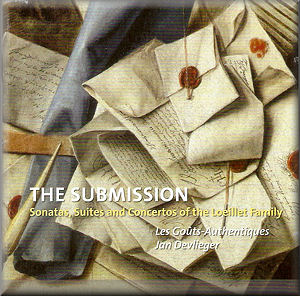 |
 |
|


alternatively
CD: MDT
AmazonUK
AmazonUS
|
The Submission - Sonatas, Suites and Concertos
of the Loeillet Family
Jacques (Jacob) LOEILLET (1685-1748)
Sonata in B minor for two voice flutes, two transverse flutes and
basso continuo [9:39]
Concerto in D major (Woodcock III) for transverse flute, two violins
and basso continuo [9:32]
Concerto in E flat major (Woodcock XII) for oboe, strings and basso
continuo [8::47]
Jean Baptiste LOEILLET (1688-c.1720)
Sonata in A minor for two recorders Op.1/1 [9:07]
John (Jean Baptiste) LOEILLET
(1680-1730)
Sonata in G minor for recorder, oboe and basso continuo Op.1/III
[7:52]
Suite III in C minor for harpsichord [11:29]
Dance Tunes (edited Jan Devlieger) [7:54]
Jan DEVLIEGER (b.1967)
Reflections on a tune by Mr. Loeillet for string quartet [1:411]
 Les Goûts-Authentiques/Jan Devlieger
Les Goûts-Authentiques/Jan Devlieger
rec. October-November 2010, Concert Hall Miry, Conservatory of Ghent
 ETCETERA KTC 1434 [66:33]
ETCETERA KTC 1434 [66:33]
|
|
|
The disc’s title sounds rather erotic, but ‘The Submission’ is a dance by the English dancing master Kellom Tomlinson. The disc’s subtitle is, by contrast, succinct and precise: Sonatas, Suites and Concertos of the Loeillet Family. This Ghent family made its way to London where it flourished, though it involves an act of will, and a certain amount of alcohol, to distinguish John (Jean Baptiste) Loeillet (of London, but born in Ghent in 1680) from his father Jean Baptiste François Loeillet (of Ghent, not London) and Jacques (Jacob) Loeillet -who was the brother of John (Jean Baptiste). By which point one wishes for nicknames.
If only this was the end of it. The flute and oboe concertos in this disc have been attributed by some musicologists not to the Loeillet clan – Jacques, Jean Baptiste or John and their various bracketed permutations - but to one Robert Woodcock (1690-1728) under whose name some of the movements were certainly published in around 1727. It would be spoiling the fun to reveal the ins and outs of these attributions, misattributions and indeed non attributions, so Jan Devlieger’s interesting notes are the place to start.
Whoever wrote what, the music is both entertaining and engagingly performed. Jacques’s Sonata in B minor is for two voice flutes, two transverse flutes and basso continuo and its discourse is chatty with the good recording ensuring that the continuo is well balanced throughout. Jean Baptiste – the father, remember, of John (Jean Baptiste) – contributes a Sonata in A minor for just two recorders which reaches a height of expression in the lovely slow movement where the instruments coil suggestively around each other in a decidedly affectionate sort of way.
The works of the father are followed by those by the son, John. His Sonata in G minor for recorder, oboe and basso continuo is one of the best things here, with melodic lines held back or cannily distributed for maximum effect. The Adagio is especially lovely. His so-called Suite III in C minor is for harpsichord. The dance movements are lively and engaging, and the music sounds to me strongly influenced by Purcell and Blow’s keyboard writing.
Those Concertos – whether by Jacques or Woodcock – are spry and springy, and require quick deft breathing. The gracefulness and graciousness of the opening of the E flat major is an especially nice moment but vibrancy is a feature, once again, both of music and performance. The Submission appears in the dance tunes by Tomlinson based on John Loeillet’s music. These very brief catchy dances attest to the splendid popularity of the dancing master. Tomlinson was up and coming, and in later years was to write a book called The Art of Dancing (fair enough – no ambiguity there). Finally, Devlieger delivers himself of a reflection on a tune by Loeillet – just under two minutes of quiet melancholy for string quartet.
Indeed Devlieger, treble recordist, voice flautist, harpsichordist, arranger and composer is a modern-day Loeillet, though which one perhaps only he can tell. His multi-faceted band plays with splendid authority and sonority, full of colour and command, passion and precision. Fine recording, too, and engaging notes.
Jonathan Woolf
|
|

